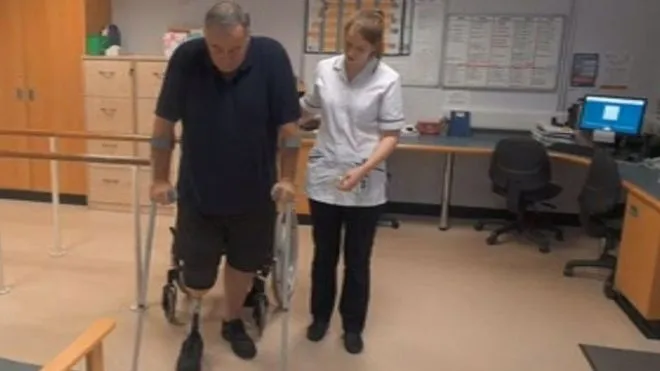Stephen Richardson underwent a leg amputation due to complications of type 2 diabetes.
"The specialist told me: 'We are going to have to amputate this afternoon because if we don't do it tomorrow you will be dead.'"
Stephen Richardson tells him, a 58 -year -old British who is learning to walk without a leg after his other limb was amputated.
The cause: type 2 diabetes, a disease that is not attended can lead to serious complications, including the amputations of lower limbs, and even death.
This is another surprising cause of type 2 diabetes that you may never have thought
Only in the United Kingdom, every week 170 people are subject to an limb amputation due to diabetes.
And according to the International Diabetes Federation, it is estimated that around the world every 30 seconds a lower limb, or part of it, is amputated as a result of this disease.
In recent years there has been a drastic increase in the prevalence of diabetes in the world.According to the World Health Organization (WHO) 422 million people live with the disease.
1.6 million of these patients die every year.And the loss of lower extremities as a result of complications of diabetes, has become a serious social, economic and public health problem.
For Stephen Richardson, his amputation has had a huge impact on his life and his family.
"I have two grandchildren, two and four years old, and Emily, my eldest granddaughter, when she saw me in the hospital without a leg I didn't want to approach me. This hurt me a lot," he told the BBC.
"Now I usually sit alone in the garden, I feel to think, I wonder what I am going to do now, what follows in my life?" He says.
Diabetes is a metabolic and chronic disease, characterized by high blood glucose levels, which over time leads to serious damage to the heart, blood vessels, eyes, kidneys and nerves.
Most people suffering from this disease, such as Stephen, have type 2 diabetes.
This occurs mainly in adults, when the body becomes resistant to insulin - the hormone produced by the pancreas and helps level blood glucose levels - or cannot produce enough insulin.
A complication of type 2 diabetes is the loss of lower extremities caused by the so -called diabetic foot.
According to WHO in the last three decades, the prevalence of type 2 diabetes has increased dramatically in all countries.
Pray diabetes form is type 1, which used to be called youth diabetes because it mainly affects children and young people.
In this the pancreas produces little or no insulin.
For people with diabetes, access to treatments, which include insulin, is essential for both survival and for the prevention of complications.
Persistently high blood glucose levels can cause serious damage to the body that include renal failure, loss of vision, neurological damage, risks of cardiovascular problems, including heart attacks and strokes.
Another devastating complication is the loss of lower extremities caused by the so -called diabetic foot.
This feet problem arises due to neuropathy (nerve damage) and poor circulation caused by high blood glucose levels.
"If I had done what they told me I would not be in this situation," says Stepehen Richardson.
Neuropathy causes loss of feet sensation which decreases the ability to feel pain or injuries.
And poor circulation decreases the body's ability to heal, which hinders the healing of infections, injuries or wounds.
There is no cure for the disease, but it is possibleControl it with a rigorous diet with medications, which include insulin.
After his amputation Stephen Richardson told the BBC that he admits that he ignored the advice of his doctors about his diet and physical exercise.
"This is not anyone else's fault, it is my fault. I do not blame surgeons, or doctors, I do not blame any person, only myself," he says.
"If I had done what they told me I would not be in this situation," he adds.
If I had done what they told me I would not be now in this situation "
Experts claim that simple changes in lifestyle can be effective in prevention of type 2 diabetes.
These include a healthy diet, regular physical activity, maintaining normal weight and avoiding tobacco.
And for those who have already been diagnosed with the disease, in addition to those changes in the lifestyle, it is necessary to keep control of their medications and undergo regular analysis to avoid complications.


